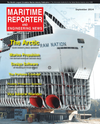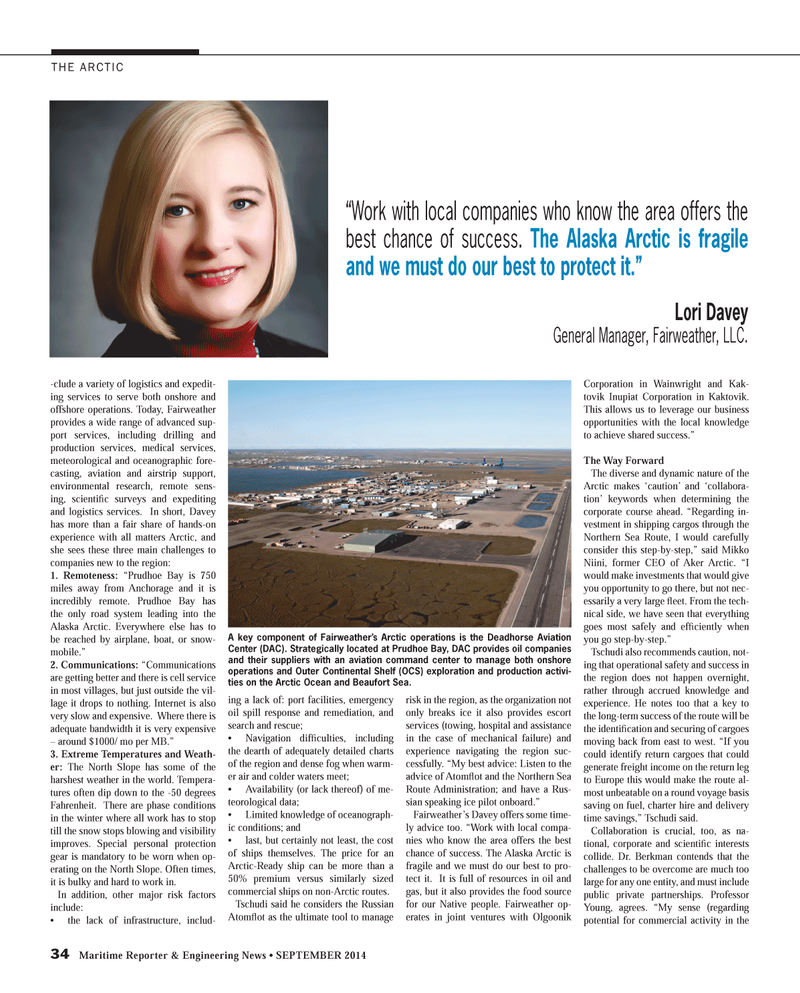
Page 34: of Maritime Reporter Magazine (September 2014)
Marine Propulsion Edition
Read this page in Pdf, Flash or Html5 edition of September 2014 Maritime Reporter Magazine
34 Maritime Reporter & Engineering News • SEPTEMBER 2014
THE ARCTIC -clude a variety of logistics and expedit- ing services to serve both onshore and offshore operations. Today, Fairweather provides a wide range of advanced sup- port services, including drilling and production services, medical services, meteorological and oceanographic fore- casting, aviation and airstrip support, environmental research, remote sens- ing, scientifi c surveys and expediting and logistics services. In short, Davey has more than a fair share of hands-on experience with all matters Arctic, and she sees these three main challenges to companies new to the region: 1. Remoteness: “Prudhoe Bay is 750 miles away from Anchorage and it is incredibly remote. Prudhoe Bay has the only road system leading into the
Alaska Arctic. Everywhere else has to be reached by airplane, boat, or snow- mobile.” 2. Communications: “Communications are getting better and there is cell service in most villages, but just outside the vil- lage it drops to nothing. Internet is also very slow and expensive. Where there is adequate bandwidth it is very expensive – around $1000/ mo per MB.” 3. Extreme Temperatures and Weath- er: The North Slope has some of the harshest weather in the world. Tempera- tures often dip down to the -50 degrees
Fahrenheit. There are phase conditions in the winter where all work has to stop till the snow stops blowing and visibility improves. Special personal protection gear is mandatory to be worn when op- erating on the North Slope. Often times, it is bulky and hard to work in.
In addition, other major risk factors include: • the lack of infrastructure, includ- ing a lack of: port facilities, emergency oil spill response and remediation, and search and rescue; • Navigation diffi culties, including the dearth of adequately detailed charts of the region and dense fog when warm- er air and colder waters meet; • Availability (or lack thereof) of me- teorological data; • Limited knowledge of oceanograph- ic conditions; and • last, but certainly not least, the cost of ships themselves. The price for an
Arctic-Ready ship can be more than a 50% premium versus similarly sized commercial ships on non-Arctic routes.
Tschudi said he considers the Russian
Atomfl ot as the ultimate tool to manage risk in the region, as the organization not only breaks ice it also provides escort services (towing, hospital and assistance in the case of mechanical failure) and experience navigating the region suc- cessfully. “My best advice: Listen to the advice of Atomfl ot and the Northern Sea
Route Administration; and have a Rus- sian speaking ice pilot onboard.”
Fairweather’s Davey offers some time- ly advice too. “Work with local compa- nies who know the area offers the best chance of success. The Alaska Arctic is fragile and we must do our best to pro- tect it. It is full of resources in oil and gas, but it also provides the food source for our Native people. Fairweather op- erates in joint ventures with Olgoonik
Corporation in Wainwright and Kak- tovik Inupiat Corporation in Kaktovik.
This allows us to leverage our business opportunities with the local knowledge to achieve shared success.”
The Way Forward
The diverse and dynamic nature of the
Arctic makes ‘caution’ and ‘collabora- tion’ keywords when determining the corporate course ahead. “Regarding in- vestment in shipping cargos through the
Northern Sea Route, I would carefully consider this step-by-step,” said Mikko
Niini, former CEO of Aker Arctic. “I would make investments that would give you opportunity to go there, but not nec- essarily a very large fl eet. From the tech- nical side, we have seen that everything goes most safely and effi ciently when you go step-by-step.”
Tschudi also recommends caution, not- ing that operational safety and success in the region does not happen overnight, rather through accrued knowledge and experience. He notes too that a key to the long-term success of the route will be the identifi cation and securing of cargoes moving back from east to west. “If you could identify return cargoes that could generate freight income on the return leg to Europe this would make the route al- most unbeatable on a round voyage basis saving on fuel, charter hire and delivery time savings,” Tschudi said.
Collaboration is crucial, too, as na- tional, corporate and scientifi c interests collide. Dr. Berkman contends that the challenges to be overcome are much too large for any one entity, and must include public private partnerships. Professor
Young, agrees. “My sense (regarding potential for commercial activity in the “Work with local companies who know the area offers the best chance of success. The Alaska Arctic is fragile and we must do our best to protect it.”
Lori Davey
General Manager, Fairweather, LLC.
A key component of Fairweather’s Arctic operations is the Deadhorse Aviation
Center (DAC). Strategically located at Prudhoe Bay, DAC provides oil companies and their suppliers with an aviation command center to manage both onshore operations and Outer Continental Shelf (OCS) exploration and production activi- ties on the Arctic Ocean and Beaufort Sea.
MR #9 (34-39).indd 34 9/4/2014 3:27:37 PM

 33
33

 35
35
